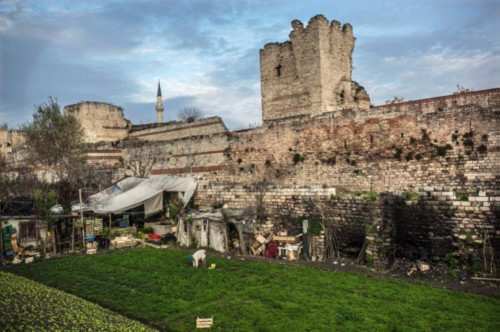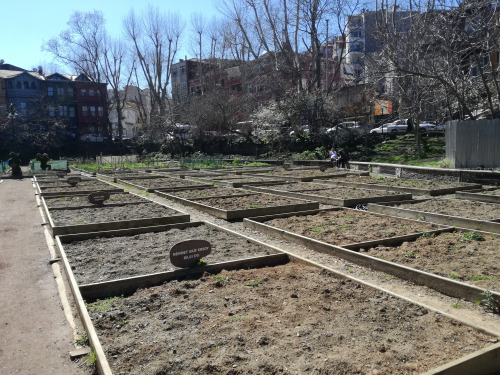
While doing research on the Neolithic and Byzantine agricultural economy of Istanbul through archaeobotanical data, I can’t help talking about the ‘bostan’s (urban gardens) of Istanbul as resisting historical, cultural, and agricultural values. Sources mention that the urban gardens had the potential to meet the vegetable needs of Istanbul until the second half of the 20th century. For example, until the 12th century, the vegetable needs of the people of Constantinople were met in the gardens near the city walls of the historic Yedikule district. In the 16th century, the Turkish traveler Evliya Çelebi recorded 4395 gardens within the borders of Istanbul, and a historical map of Istanbul dating from 1883 shows a total of 102 gardens in the walled city. It is noted that there were more than 1200 gardens on the Asian and European sides of Istanbul in the 1900s, and they could meet the city’s fruit and vegetable needs.
It is known that the Yedikule Bostans, the most known in Istanbul, have existed since the 400s when the Theodosian Walls were built. In the beginning, Greeks and Armenians were engaged in gardening activities, and later in the Ottoman Empire, Albanians continued these activities. In the 1890s, people coming from the rural areas of Kastamonu (a city in the Black Sea Region) learned gardening from Albanians. And today, their third-generation descendants continue this tradition. These historical gardens around the Land Walls of Istanbul, accepted as a World Heritage Site by UNESCO in 1985, are a cultural heritage where agricultural knowledge has been transferred from generation to generation for centuries by means of water wells, ponds and the terracing system.

The Yedikule Bostans in the 1900s. (Source: Ousterhout, R., ve Başgelen, N., 1995. Tarihi Kartlarda Yaşayan İstanbul, Osmanlı Öncesi Anıtları, Arkeoloji ve Sanat Yayınları, İstanbul)
Another historical urban garden in Istanbul is the Piyalepaşa Mosque (Camii) Bostans covering an area of 6500 m² and located near Piyalepaşa Mosque (Camii), which was built in 1573 by the Ottoman architect Mimar Sinan. It is known that the whole of this area was the urban garden before the mosque was built. Another historical garden is the Kuzguncuk Bostans, located near Üsküdar district on the Asian side of Istanbul. This urban garden is said to date back to 700 years ago. Rumor has it that this urban garden belonged to a Greek aunt called Ilya, who was living in Kuzguncuk. When she died, the urban garden remained idle since she had no inheritor, but people of Kuzguncuk have always protected this area. Apart from the agricultural activities, the Kuzguncuk Bostans have also turned into a habitat where people of Kuzguncuk are socialized.

The grid system in the Kuzguncuk Bostans (Photo: Burhan Ulaş). Today’s Kuzguncuk Bostans do not reflect the historical reality.
Traditional cultivation and irrigation methods have been used in the urban gardens of Istanbul for centuries. This method is a grid system made by shaping the soil in the square form. In this system, each square is called “tava/maşula”. A wide range of products such as tomatoes, purslane, basil, celery, parsley, cauliflower, cabbage, spinach, onion, radish, broccoli, cress, and mint are grown in these urban gardens.
In addition to the aforementioned historical gardens, various areas that were urban gardens in the past in Istanbul’s districts of Pendik, Aydos, Caddebostan, Kaynarca, Tuzla, İçmeler, Arnavutköy, Habipler, and Mahmutbey have continued under the name of “Bahçe” (smaller agricultural lands compared to bostans). Apart from these, Kanarya, Halkalı, and Altınşehir regions still continue their existence as urban gardens today.
Now that we have mentioned the urban gardens, we also need to talk about the waterways associated with agricultural activities such as cisterns and aqueducts dating from the Byzantine Period. It is suggested that there are about 100 large and small covered cisterns in the Sultanahmet area alone. It is known that in addition to covered cisterns, the buildings with a wall thickness of around 4 to 5 m and that are approximately 10 to 15 m below sea level were used as urban gardens in the past and are named as “çukurbostan” (pit gardens) by Istanbulites today. The construction periods of the three cisterns inside the Walls of Istanbul (Suriçi), some of the uncovered cisterns mentioned as “çukurbostan” above, are as such: Karagümrük Çukurbostanı, which is located under the Karagümrük Sports Club Building today, was built in 421 in the period of Praefectus Aetius. Xerokopion Cistern (Çarşamba Çukurbostanı) was built in 459 in the period of the Goth commander Aspar, who was in the Imperial service, and Fındıkzade or Altımermer was built in the period of Hagios Mokios, the Roman governor of the Asian province. All these mentioned urban gardens and cisterns, as well as archaeological, archaeobotanical, and anthropological data show that Istanbul, which has now turned into a concrete jungle, was an agricultural center for centuries.
Since the beginning of the 21st century, the rapid expansion phenomenon for urban agriculture has emerged. Agricultural practices in cities have led to the creation of a communication channel between local administrative and political institutions and citizens (although this is often painful and full of conflict). As a result of this communication channel, the area where the Land Walls of Istanbul are located, including the Yedikule Bostans, was registered in the UNESCO World Heritage List. In this regard, it can be argued that the urban gardens are a representation of a new urban concept, which is the key to social transformation that characterizes today’s world. In this sense, it is inevitable that the new dynamics emerging around the urban gardens between the administrators of cities and citizens will ensure social transformation as well as the preservation of historical and cultural values.
Sources
A. Ricci, “A Resilient Landscape: The Land Walls of Constantinople and Their Surroundings,” Deltion of the Christian Archaeological Society S. 4, Vol. 39 (2018), 125–138
A. Shopov and A. Han, “Osmanlı İstanbul’unda Kent İçi Tarımsal Toprak Kullanımı ve Dönüşümleri: Yedikule Bostanları,” Toplumsal Tarih 236 (2018): 34–38
C. White, A. Shopov, and M. Ostovich, “An Archaeology of Sustenance: The Endangered Market Gardens of Istanbul,” Archeology for the People: Joukowsky Institute Perspectives, eds. J. Cherry and F. Rojas. Joukowsky Institute Publication 7, 2015: 29–38. Oxford, UK
https://khasyedikulebostanlari.wordpress.com/
https://www.arkeologlardernegist.org/assest/images/A_PIYALEPASA%20KORUMA_2017.07.pdf
http://www.atlasdergisi.com/gundem/yedikule-bostanlari-mirasin-talani-2.html

